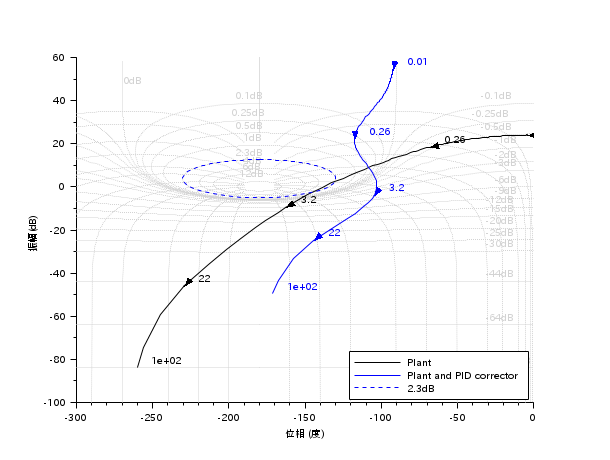Please note that the recommended version of Scilab is 2026.0.0. This page might be outdated.
See the recommended documentation of this function
black
Black図 (ニコルス線図)
呼び出し手順
black( sl,[fmin,fmax] [,step] [,comments] ) black( sl,frq [,comments] ) black(frq,db,phi [,comments]) black(frq,repf [,comments])
パラメータ
- sl
リスト ( 線形システム
syslin)- fmin,fmax
実数スカラー (周波数範囲)
- frq
行ベクトルまたは行列 (周波数)
- db,phi
行ベクトルまたは行列 (絶対値, 位相)
- repf
行ベクトルまたは行列 (複素周波数応答)
- step
実数
- comments
文字列
説明
線形システムslのブラック図 (ニコルス線図).
sl は連続時間または離散時間 SIMOシステム
とすることができます(syslin参照).
多出力系の場合, 各出力は異なる記号でプロットされます.
The frequencies are given by the bounds
範囲fmin,fmax (単位: Hz)
または行ベクトルfrq
(多出力系の場合は行列)
で指定された周波数.
step は ( 対数 ) 離散時間刻みです.
(デフォルト値の選択については calfrq 参照).
commentsは文字列(キャプション)のベクトル
です.
db,phi は絶対値 (単位: dB)および
位相 (単位:度)の行列です.
repf は複素行列です.
各行は各応答に対応します.
y/(1+y)の
等ゲイン,等位相のグリッドをプロットするには,
nicholschart()を使用してください.
fmin およびfmax のデフォルト値は,
sl が連続時間系の場合に
1.d-3,1.d+3,
sl が離散時間系の場合に1.d-3,
0.5/sl.dt (ナイキスト周波数)
となります.
例
//Black diagram s=poly(0,'s'); sl=syslin('c',5*(1+s)/(.1*s.^4+s.^3+15*s.^2+3*s+1)) clf();black(sl,0.01,10);

//Black diagram with Nichols chart as a grid s=poly(0,'s'); Plant=syslin('c',16000/((s+1)*(s+10)*(s+100))); //two degree of freedom PID tau=0.2;xsi=1.2; PID=syslin('c',(1/(2*xsi*tau*s))*(1+2*xsi*tau*s+tau.^2*s.^2)); clf(); black([Plant;Plant*PID ],0.01,100,["Plant";"Plant and PID corrector"]); //move the caption in the lower rigth corner ax=gca();Leg=ax.children(1); Leg.legend_location="in_lower_right"; nicholschart(colors=color('light gray')*[1 1])

参照
| Report an issue | ||
| << Plot and display | Plot and display | bode >> |